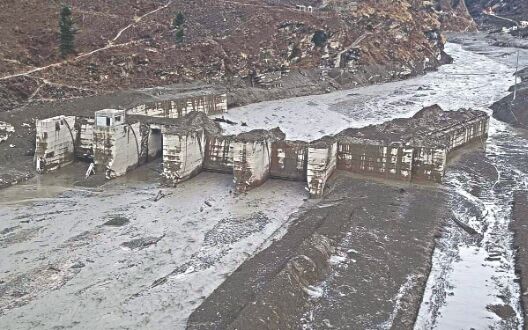Caution or consequences!
Development projects in ecologically sensitive areas must be followed by a proper assessment to avoid disastrous outcomes; write Aparajita & Debapriya Mukherjee

The February 7 massive flood devastated the Himalayan Valley in Uttarakhand, tearing through two hydroelectric dams and killing more than 70 people. There had been massive flooding in Rishiganga, Dhauliganga and Alaknanda rivers. Several bridges, roads, homes and hundreds of grazing sheep, cattle and goats were swept away in the deluge. It was a surge of water, thought to be triggered by a glacial outburst in Nanda Devi mountain. Worldwide, millions watched the tragedy unfold on their television screens and realised its humanitarian cost. They were in search of causes for frequent disasters as the recent flood was just reminiscent of the 2013 floods that killed thousands of people.
While many speculate the reason to be the outburst of a glacier, others attribute the disaster to the ecological impact of climate change and extensive construction and human activities in the Himalayan valley. The structurally unstable and young Himalaya is still geologically active, fragile and vulnerable to both natural and man-made processes. An avalanche or a cloud burst may be natural, but the impact of this disaster is local and man-made. Glacial outburst is highly unusual during the winters. Global warming in the upper reaches of the Himalayas could be a possible reason for the rapid melting of the glaciers. Researchers had already warned that global heating would become a huge problem for the region in the next few years. A 2019 survey found that glaciers in the Himalayas have been melting at double speed since 2000, losing nearly a vertical 50 cm of ice each year.
In the era of globalization and modernisation, the government practically overlooked the natural ecosystem and carrying capacity of the Himalaya. It also neglected traditional beliefs and norms of nature conservation despite apprehensions expressed by environmentalists and locals around dangerous and unsustainable development. These reckless development plans indicate that science is being operated without an iota of conscience. The top-level managerial personnel, engineers and scientists are carrying out their job without accountability and responsibility under political and corporate support.
The number of pilgrims going to the Himalayas has increased exponentially over years. This expansion of tourism has created vulnerabilities in the entire region — turning regional extreme weather events into national disasters. Uttarakhand is one such pilgrimage centre. To fulfil the needs of large number of pilgrims, an intricate network of roads, hotels, lodges and related support systems has been built in the remote mountains. Around 50,000 trees have been felled under the Chardham road project to connect the pilgrim spots in Uttarakhand. The 900-km long road is being constructed at a cost of Rs 12,000 crore.
The project has been broken into 53 contracted road projects thus bypassing the requirement of Environmental Impact Assessment (EIA) report before initiation of the project. The loopholes in the EIA mechanism obstruct it from preventing the destruction of this fragile ecosystem in the name of development. The broadening of road means the mountains have been vertically sliced. Reconstruction of roads and other infrastructure at a hurried pace for tourism could further aggravate existing vulnerabilities and create new ones, laying the ground for potential disasters. It is clear that the policymakers who approve these schemes either do not understand scientific evidence or simply choose to ignore it.
Uttarakhand is known as the 'energy state' of India due to more than 500 large and medium-sized commissioned hydro projects and several other under-construction projects. Though the mega hydro-projects are blamed as environmental menace, medium and small projects are also being constructed at a large scale to utilize valuable water resources for electricity generation without taking into account the future consequences. These require stream diversion, large-scale excavation of rock by blasting, tunnelling and dumping loose rock debris/soil thus making unstable landforms prone to slope instability.
Additionally, the construction of multi-storied buildings and domestic houses in high-risk earthquake zones is also a matter of concern. The building of houses in the region has shifted from mud, wood, rock-slab, and other bio-materials to semi-concrete and concrete — mostly because of a ban on timber and availability of new building materials. Now, even a medium level earthquake causes larger damage in the region. The developmental constructions are also unsustainable. The accountability rests on the government, politicians and engineers involved in such constructions.
The government should scientifically implement development projects and carry out an environmental assessment before the implementation of these projects in ecologically sensitive areas. Policymakers must actively engage with scientists and experts on the problems faced by Himalayan people. Global warming can grab headlines, but many of the other pressures on the fragile mountain region remain mundane. The landscape is changing with the growing human population. Cattle grazing and rampant deforestation will drive nearly one-quarter of local species to extinction and disrupt the natural flow of water. Scientists and engineers must emphasize more forcefully that rampant building construction should not be permitted by any means on riverbanks or flood plains that are constantly swept by monsoon floods.
If the people of the Himalayas were more aware of the geological vulnerability and ecological fragility of their mountain home, they would comply with laws to protect it.
Views expressed are personal



